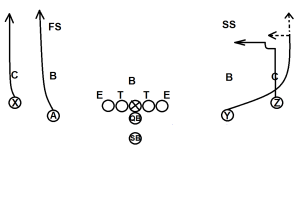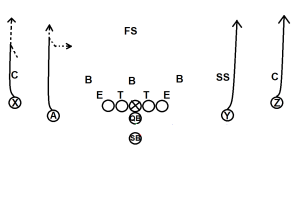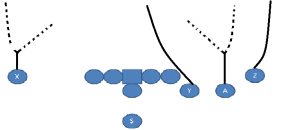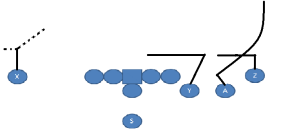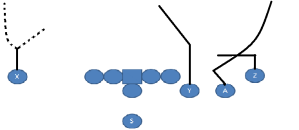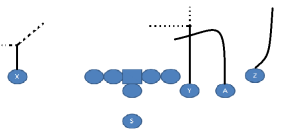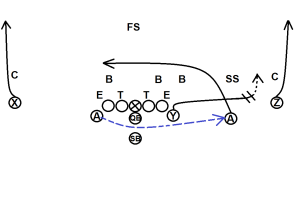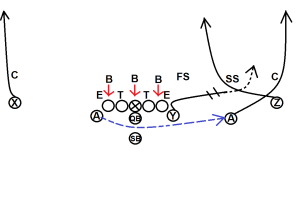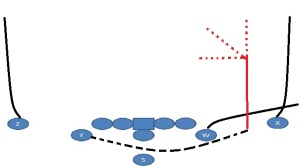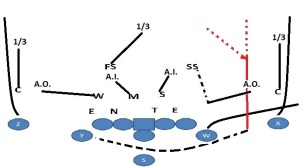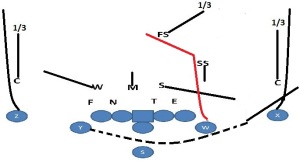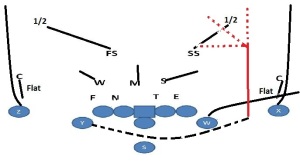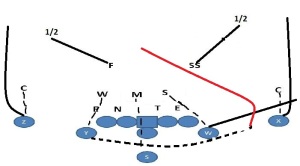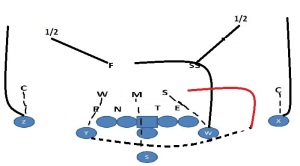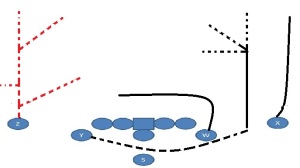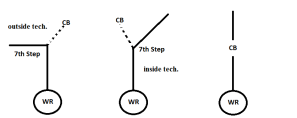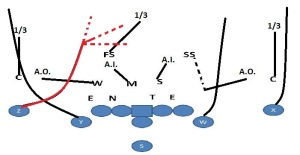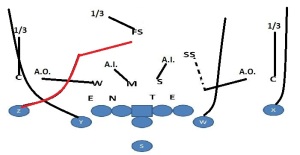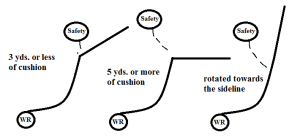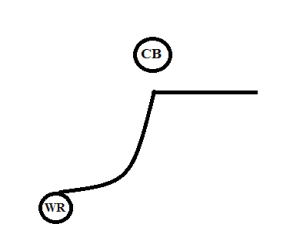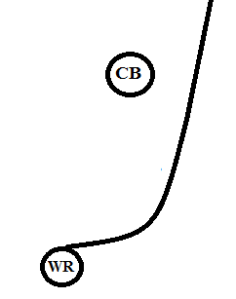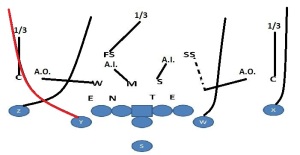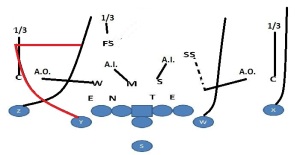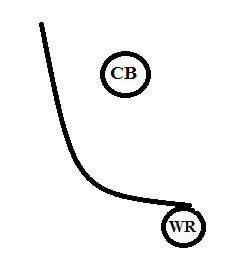“Understanding Coverages”
Now that we have covered the basic Run& Shoot offensive philosophy and specifically how it relates to coverages we can focus more on the details of each coverage type. All of the text in quotes was pulled from John Jenkins 1985 QB Manual.
During each offensive play the receivers and the quarterback will need to be able to identify and react to the defensive coverage. This is not a passive offensive system. In the previous post I discussed how the Run & Shoot limits the possible number of defensive coverages that can be employed and also forces the defense to make those coverages simpler. However, even with simpler coverages it can be difficult and impossible for even the coaching staff to truly identify the defensive coverages being used. Therefore, the Run & Shoot, breaks all possible defensive coverages into five basic and easy to differentiate categories:
- Cover 4 (3 Deep or 4 Deep Zone)
- Cover 2 (2 Deep Zone)
- 5 Under (2 Deep Zone Man Under)
- Man Free (Cover 1 Man)
- Man Blitz (Pure Man)
Each of these categories of course had their own subcategories, but this is how they broke up all the possible coverages they would see. As I said earlier breaking these coverages up into these simple categories provides the offense with five easily distinguished categories making it very easy for both the quarterback and receivers to identify the coverage both pre and post snap. Therefore, it will be easy for the receivers to adjust their routes to beat the coverages after the snap and for the quarterback to then “shred” the defense.
1.) Cover 4
“Cover 4 is what we acknowledge as a three deep zone coverage. From an underneath standpoint, we have seen a balanced 4 man underneath combined with a 4 man rush and also have been confronted with a 5 man underneath attempted coordinated with a 3 man rush from a 3-4 front structure.”
“1.) 4 Coverage is not and has not ever been designed to handle the short passing game.
a.) With their constant philosophy of forcing the offense to drop the ball off to the short defender, drive up and make a sure tackle for a minimal gain sounds acceptable and theoretically sound but yet our offense will patiently take the short GO’s, slides, and the 3rd Choice from the Choice and settle for the 4 yard continual gains. What back in a strong running offense is assured of a constant 4 yard gain? And with this principle applied, when we break a tackle from one of these short routes, it turns into a big “chunk” of yardage. This obviously is true of any zone coverage.
Each defensive coverage must give something up. Cover 4 with its three deep zone defenders (and occasionally four) is designed to protect against the deep pass. Therefore, Cover 4 is going to routinely give up the short pass. Each one of the major Run & Shoot passing concepts has a short rout (typically a flat route) which will be open for an automatic short gain. This automatic short gain is putting the defensive back up against the wide receiver all alone in the open field. So, not only is this short gain almost automatic if the receiver breaks the tackle of the defensive back he is guaranteed a big gain. After all, if the defense keys in on these short routes the offense can just take a big gain deep down the field.
2.) The balanced zones can be repeatedly ripped by our own flooding routes–Motion Back Flag, Wing Post or Flag, Y Flag, S Flag, etc.
Cover 4, like most any zone coverage must cover the entire field equally. Zone coverage, unlike man coverage, relies on anticipating where the offense will throw the ball. In anticipating where the offense will throw the ball the defense must cover all potential options equally, if the defense does not do this the offense will simply throw where the defense isn’t. However, if the defense covers all areas of the field equally before the snap they cannot match up against the offense if the offense only attacks one area of the field. Flooding routes will do just that, attack one area of the field.
3.) 4 Coverage is beaten deep by our own design in stretching the vertical areas and hitting the deep overlap seams.
EXAMPLE: The Switch, the under coverage clearance of the motion back on Z or X GO Route, the deep breakback of Y or Wing on the Slide variation and the natural deep breakback of the motion back on Z or X Go. And certainly working the 2nd receiver up the college hash area in the CHOICE has provided an opportunity for a big gain in yardage.
Rather than write about this I will let the diagrams speak for themselves. Notice how in each diagram the defensive players are outnumbered in their respective defensive zones.
4.) Rotation coverage in Cover 4 certainly leaves the defense “hanging out” as we work the corner over in his corner roll attempt on the GO and hit those overlap seam areas that I listed previously.”
If the defense attempts to overcompensate for a particular route by rolling coverage over in that direction they must leave a hole somewhere in their coverage. Think of it this way the defense only has so many great athletes (those defenders capable of matching up with the offenses wide receivers) and it must choose where to position these defenders. If the defense moves these defenders to favor a certain area of the field they cannot be in another spot. That is, for each area the defense adequately covers they leave another open.
4 Variations of Cover 4
- -4 Invert (Sky Safety)
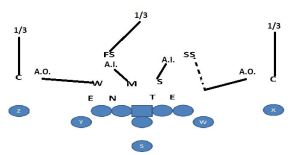
- -4 Cleo (Corner roll – 2 look with safety over the top into the outside one-third deep area.)

- -4 Buzz (Backer outside into the curl-flat underneath area with the safety “setting up camp” in the curl).

- -4 Across (Corners and safeties playing deep one-fourth responsibilities working deep down the boundaries and college hashs. Generally this is associated with the 3 man rush scheme in order to also keep a balanced cover scheme underneath).
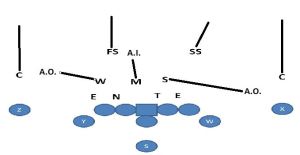
“All 4 major routes are extremely effective vs. 4 Invert with the switch possessing the highest degree of potential damage. The Go and the Slide exhibit an extremely high percentage rate against it, as well as the Choice (Special) when checking down to the third choice. And the intermediate and long gains are presented in working vertical stretch of 4 Invert.”
Cover 4 Invert is the basic Cover 4 coverage and therefore the most frequently seen of all Cover 4 varieties. Therefore, all of four major Run & Shoot concepts are extremely effective against it. The defense will pull out all other major Cover 4 packages in order to shut down certain routes and passing concepts. All other Cover 4 packages are more complicated for the quarterback. When the defense is finally forced into 4 Invert (as they inevitably will be) they are playing right into the offense’s hands. This is exactly what the offense has been looking for this entire time. Because this is the coverage the offense has been trying to force the defense into the offense is designed to shred the defense when it finally ends up in this coverage.
Switch vs. Cover 4 Invert
“This is without a doubt the most deadly weapon in our arsenal vs. 4 Invert in addition to the Cleo and Buzz variations. Any way you wish to slice it we possess the threat of 4 deep receivers, all having equal distribution of 18 yards of one another with deep stretches downfield. From a defensive standpoint, the 3 deep cover guys must in turn be able to overlap this amount of territory which basically starting from the center portion of this 18 yard chunk of grass. And also considering the fact that they are running like hell backwards with you (QB) looking them off with your eyes then theoretically it is possible to either score every time vs. this coverage or at least “scorn” them for big dirt.”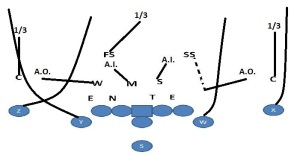
Cover 4 Invert, Buzz, and Cleo are referred to as Cover 3 defenses in most systems. This is because these defensive coverages only have three deep zone defenders. Therefore, if the offense sends four receivers into these deep zones one of the deep zone defenders will be forced into defending two receivers, this is impossible. Each time a play with four deep threats is called versus a defense with only three defenders the offense has the potential to complete a throw in the deep zone for a large chunk of yards.
- Cover 4 Cleo

“Here a great possibility exists in hitting the wide out quick as we create a “Fronting & Backing” read for the corner, who has flat responsibility. As you deliver the ball to the wideout the corner will often jump the slot in the flat as it sails over the slot and himself.
“The Primary Precaution to take in your read (QB) is to be sure and get a read or a peripheral view of the safety moving over the top into the outside third just before the snap. You do not want to allow the wideout to get too far a stretch down the rail in 4 Cleo as he will run into the safeties overlap…If the corner continues to sink or if he is playing a “soft” technique deep merely bring your read on to the underneath defender in the curl and hit the season or the flat.”
Cover 4 Cleo is a fundamentally unsound defensive coverage. Not only does the possibility exists to hit the one of four deep receivers downfield as described above, but this coverage also creates a hole immediately behind the right cornerback. Unlike Cover 4 Invert where the cornerback drops straight back into a deep zone the right cornerback instead covers a flat zone and the free safety must scramble over into the deep zone on the sideline. This coverage is forcing the safety to cover 18 yards of grass which he is out of position to cover. If the receiver lined up directly across from the right cornerback just runs straight downfield he should be open immediately behind the cornerback and in front of the safety.
- Cover 4 Buzz (safety in hook Zone)

“Go just read the linebacker but otherwise the same, Slide same reads as usual, Choice with a deeper safety the wideout must hold the corner longer, and the same for Switch
Cover 4 Buzz provides pretty simple reads for each one of the four major Run & Shoot concepts. For the Go concept the linebacker is read instead of the strong safety as would be read in Cover 4 Invert. For both the Choice and Switch concepts the same reads are employed as would be for Cover 4 Invert except that the wideouts must make sure they are holding the cornerbacks deep down the field so that they are not interfering with the intermediate routes. The reads are not changed in anyway for the Slide concept.
- Cover 4 4 Across

“The look does require a little different thinking as the deep vertical stretch theory is non-existent although the seams are so high the underneath that our receivers can force a cushion deep – throw the hand up and hit anything in the deep intermediate area. And with a 3 man rush we have the capability of getting a double on all of the rushmen so the “shooting gallery” sensations would be back.”
Cover 4 4 Across, unlike the other Cover 4 Coverages has four deep defenders. Because of the four deep defenders the four on three deep attack described earlier will not work. Instead of attacking the deep zones the offense will instead attack the shallow and intermediate zones. With four deep defenders the defense only has three defenders to cover both flat zones and all of the intermediate areas of the field (11 total defender-4 deep defenders + 4 rushers= 3 defenders). This should allow the wideouts to just run to the open areas of the field for an easy completion. If the defense only rushes three defenders in order to get an extra defender in zone coverage they have only made the offense’s job easier. With only three rushers each rusher can be doubled by the offenses pass blockers giving the offense an almost unlimited amount of time to complete a pass.
2.) Cover 2
“Cover 2 is what we regard as a 5 underneath zone coverage backed up by 2 deep half-field zones. We acknowledge the strength of 2 coverage to be that of having a potentially tighter underneath coverage with 5 zones. And the glaring weakness is that of the amount of ground that each safety must cover deep (27 yards). To compensate for this deficiency generally teams will divide up one of the backers to run deep with any deep middle vertical threat.”
“It has never nor will never be regarded as a strong pass coverage because of the catastrophic deep zone problem. Majoring in this coverage has sent many a secondary coach to the psychiatric and convalescent home for old coaches at a youthful age.”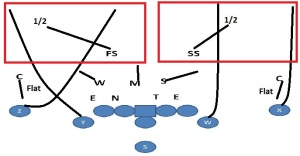
As mentioned above the vast majority of Cover 4 coverages only have three defenders covering deep zones. These coverages can be easily and consistently beaten for a large gain by sending four receivers deep. Cover 2 defenses, while covering the underneath zones exceptionally well, provide an even greater opportunity to attack the defense deep. With only two deep defenders the defense is exposing itself to the same four deep attack as Cover 4 defenses, but to an even greater effect (notice how the deep zone defenders are outnumbered in the red boxes).
“Same read between corner and safety as Cover 4 Cleo”
To make matters worse for the Cover 2 it provides the same coverage vacancy behind the cornerback as Cover 4 Cleo allowing for an easy completing behind the cornerback and underneath the safety (this is the ole circled in red).
“Pattern reads are quite frequent as the jam corners will continue to run deep with their deep fade threat so long as their flat area doesn’t get threatened. This enables the safeties to squeeze deep inside routes without being stretched.”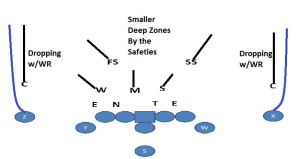
The one real saving grace of the Cover 2 is in pattern matching. Pattern matching allows the cornerbacks to go into a deep coverage with the receivers preventing the same flaws in deep coverage as other Cover 2 coverages. However, these cornerbacks will go deep with the receiver if their flat coverage is not threatened. Therefore, if an offensive play threatens both the flat zone and the deep coverage of a defense the pattern matching of Cover 2 has lost most of its effectiveness. Even if the cornerbacks follow the receivers they are essentially in man coverage which can be beaten just as easily as any zone coverage as is described below.
3.) 5 Under Coverage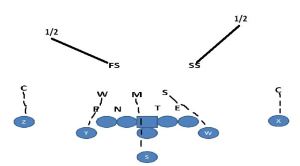
“From a very broad, general standpoint Cover 5 is simply 2 deep zone combined with man underneath. Various man techniques are applied to our 5 eligible receivers with 2 deep help defenders up top in the halves.
“As conventional offenses continued to break the huddle with 2 backs, at least one tight end and no more than 2 wide receivers, this became the solid trend in progressive pass defense. Throughout the NFL, teams found it to be difficult to continually make consistent plays on the outside to the wide-outs. So, these vanilla type offenses became reliant on working to their tight ends and runningbacks on the linebackers.
“In contrast to the 2 back, tight end type of attack, I feel that we currently reveal the most productive offense in the game in successfully attacking Cover 5. There are numerous reasons for the success that we have had, as this following list indicates some of these.
1.) Our offensive structure, which reveals 4 speed receivers and one back in an often spread like formation, gives us matchups and necessary room to execute 1 on 1 underneath.
2.) The knowledge and awareness of the coverage from a pre snap read of the receivers and the quarterback, will enable us to isolate any 1 on 1 situation underneath and beat it with our quick separation principles.
3.) The recognition of Cover 5 on a presnap read permits us to make special calls allowing us to change our routes to a specific arrangement of routes especially designed to smash into the weakest ling of this coverage. (this unique capability, beyond any other, keeps us ahead of the defense)
4.) Our sophisticated type of audibiling will allow us to select a particular play or select from a group of plays that will give us exactly what we want against a certain team using this coverage.
“We can obviously go on and on about our confidence in attacking Cover 5, but let’s examine further what this coverage entails. From our offensive perspective let’s be a little more specific about what is provided for us against Cover 5.
“1.) 5 man under with 2 deep is still 2 deep, and 2 deep certainly reveals a lot of open area to run to and catch deep balls on the go. These man-to-man defenders do assume that they have got deep help –deep help that may not always show up on time. Therefore, if we can stick or shake the underneath man techniques off of us, separate away in a vertical stretch, this coverage will give us the same big plays that Cover 2 would.
Again only providing two deep zone defenders presents a considerable defect for the offense to attack. If a receiver can shake his defender before hitting the deep zones he should be wide open for an easy gain deep down field so long as the offense is sending at least three players deep (notice how the deep defenders are out numbered in the red boxes).
“2.) As far as the possession passing game is concerned pick routes in the short and intermediate are extremely effective as well as separation moves from man under technique.”
Unlike zone coverage if a receiver beats his defender there is no other defender waiting to pick him up in coverage. If the receiver can shake his defender with simple shake routes or with a pick with another receiver the receiver will be open with absolutely no one is sight (notice how the defenders will be in one-on-one coverage with the receivers once they enter the red box).
“3.) Continuing on with more advantages schemes vs 5 coverage are certain ground schemes wthat we will apply. Generally Cover 5 is related to a tight press-bump and run. As a result our receivers now become great blockers by merely running these cover guys downfield.”
Because each defender has been given a man to cover he must follow that man anywhere on the field or he will be surrendering leverage to the receiver. If the defender does not follow the receiver the receiver will be open in the quick game again and again. However, if the defense follows the receivers the offense can pull defenders anywhere they want on the field. The offense will then pull defenders in such a way that they can always guarantee a favorable matchup in the running game.
“4.) Some other advantages include:
a.) Being able to isolate personnel to get a big mismatch in coverage/
1.) Linebacker on a receiver
2.) A “lesser” D.B. vs. one of our “little guys”
b.) Across field routes and deep cross patterns
c.) Play action combined with receiver block influence”
Firstly, just as the offense can “pull defenders” to influence the running game they can do so to influence the passing game. The offense can pull defenders so that they isolate their best player on the defenses worst player (or at least an inferior player). This creates a simple game of catch for the quarterback and receiver. Secondly, almost no defensive back can keep up with a receiver on a crossing route. The defender must follow the wideout, allowing for the possibility of the wideout breaking upfield, for almost 50 yards, this is almost impossible. Lastly, the with the offense “pulling defenders” not only can they remove defenders from the running game they can put their receivers in favorable blocking situations.
4.) Man Free
Cover 1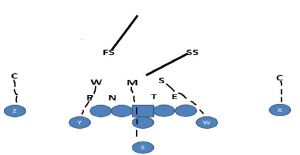
“First of all, lets fully clarify what Cover 1 is and which coverage looks fall into this major category. Generally speaking, Cover 1 is man under with one free on top. Realizing that there are 5 eligible receivers, a defense may afford to use one or two normal defenders in a special way. In other words, one defender may come on the rush (5 man rush) as another defender frees himself up as a “robber” or zone player underneath. Or there may be a 6 man rush employed. Or 2 inside backers may double up on our S Backs while the others single up and go one free up on top. At QB, this is a concern because we can’t have this guy cluttering up a passing lane with a double man look to our intended receiver.”
“From a general standpoint, it is logical to assume that our intention will be focused on attacking the weakest 1 on 1 defender underneath. This assumption is true although we are also looking to operate in the corners and down the rail. This effort will exist as long as the free safety is in true center field. The shots in the corners, down the rail, deep outside and intermediate outside, give us big play possibility with very low risk. However, we will also apply some methods of going to the middle provided we are able to influence the free safety.”
With this basic understanding of Cover 1 we can list the three main goals of an offense which is attacking this coverage.
1.) Isolate a good receiver on an underneath defender that can easily be beaten.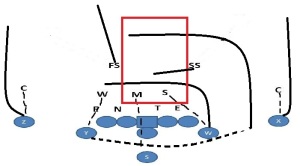
Since the defense is in man coverage the assignments of the defenders can easily be manipulated to give the offensive personnel a matchup advantage. Therefore, the offense can pick and choose which receivers are matched up against which defenders and from there the offense can assign routes to these receivers that allow them to easily beat their defender. If the defense either double covers the receiver who is trying to beat his defender or covers the middle of the field they are leaving themselves open to the next possibility of attack (the SS can only defend one of the receivers entering the red box leaving the other receiver in one-on-one coverage, if the FS enters the red box he leaves the sidelines open as shown below).
2.) Throw a deep sideline pass away from the free safety.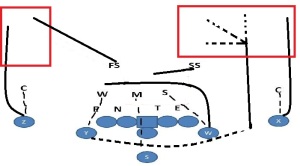
The deep zone defender (typically a free safety) is the sole extra deep defender. If the offense can run routes down the sideline the free safety will be forced to choose which sideline to defend. So, if the offense runs at least two deep sideline routes they can be guaranteed single coverage deep down the field and this is a matchup the offense should take every time (the receivers running deep routes are boxed in red, the free safety rotated to cover the weakside streak, both strongside routes in the right red box are in one-on-one coverage).
3.) Occupy the onside corner with an inside pattern that opens up sidelines.
This step is necessary to allow the previous form of attack. However, this concept can also be used on the centerfield. The offense can running a clearing route ahead of their best receiver. The clearing route should pull the extra shallow defender out of the way of the offenses best receiver allowing the easy completion (in this case the free safety is respecting the strongside deep routes, but he is still out numbered on in the red box, both outside receivers will be facing one-on-one coverage while running deep down the sidelines).
Wing-Combo Coverage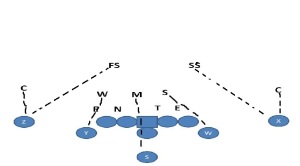
“Wing Combo is a general term that we use for an unending and multitudinous number of existing double coverage possibilities…There may be many forms of this double coverage in which “inside-outside” techniques are applied or “over-under” techniques may exist…For further clarification, I must say, if any of our 4 spread receivers are doubled up for man in any fashion, then we will place this defensive attempt in this Wing Combo category. Should the S-Back be the only one doubled, then it is not necessarily applied to Wing Combo coverage.
“To a large degree Wing Combo is brought on by defensive teams who apply “pattern-reading” into their attempt in stopping us (or any offensive system). They take the group of pass routes from their scouting breakdown and attempt to place two defenders on a particular receiver who will enter into a specific section of the field on his release. At this point, they will lock up for man coverage in a specific type of double coverage application.”
“The inside-outside coordination is generally constructed by allowing a deep route receiver to push up the field. As he enters into a short intermediate area the two defenders will build an inside-outside position on him. Their rule is defined by stating if the receiver makes an outside cut then the outside defender will lock on for man with the inside defender either closing in from inside out or being freed to help elsewhere. Should the receiver declare with an inside break, the obviously the inside defender will have the responsibility of covering him for man. The outside defender will then be freed up to help elsewhere or he may close on the same receiver from outside-in…As far as handling the receiver on a deep ball, they both are instructed to naturally keep relative distance in protecting on the deep route and not to get beat deep.”
When being opposed by a deep inside-outside double coverage will basically react 1 of 2 ways. First, they will treat the Wing Combo coverage as a 4 coverage where the safety overplays inside against their route. In this case either the receiver has a breakback possibility where he will cut his route short and breakback underneath the defender and find the passing window to the quarterback (this possibility is shown in the red box). Second the receiver may be in a position where the defenders overplay their roles. The inside defender may play to far inside and the outside defender may play to far outside. If the defenders allow this extra distance the receiver can just split them and run straight upfield (this possibility is shown in the yellow box, notice how their is not a defender lined up directly across from the receiver).
“The over-under combination is easier to play defensively and can even be performed by the use of regular defensive people (true linebackers). In this instance, as the routes develop, the backer (or under coverage guy) will run underneath the pattern in a “loose or tight trail attitude.” The upfield defender will obviously keep his relative cushion and play his man technique on the receiver from on top.”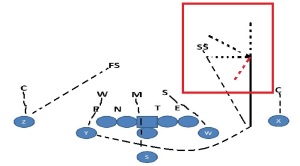
If the wing defenders give too much depth to the receiver he can just throw up his outside hand and cut down his route looking for an underneath passing lane (this is shown in the red box, notice how the SS is over top of the Y receiver and out of position to guard against the red Curl route).
“You can beat the double coverage by one of three methods. Or you will eliminate the doubled receiver (or receivers) and merely progress on to a singled receiver. After all, what more could we ask for than 1 on 1.”
5.) Man Blitz
“Within our regular “Little-People” offense, we will define a blitz read as a defensive look containing these qualities listed below:
1.) Only 4 cover guys dispersed in a one-on-one coverage position on our 4 spread receivers.
2.) 7 defenders on or near the L.O.S. in a position to rush the QB.
“Many times a pre motion read will exist well enough to declare the blitz intention. If not, our use of varied motions will uncover the blitz better than any other indicator. The blitz read can come from a variety of different front looks although we see the rush out of a 3-4 or 4-3 generally. Reasons for the balanced front and balanced blitz? Defenses are reluctant to overload us because of our quick-striking capability back to the short side by use of audibiling.
“At quarterback and receiver and throughout our protection unit, our chief priority, in this defense of ours, is to handle the blitz whenever it comes up. We must continue to improve and continue to maintain an extremely high confidence factor vs the blitz.
“Over the year, I’ve witnessed passing attacks so inept and literally brought down to their knees because of their inability to handle the blitz. When this happens to any offensive system, they had just better buckle up and hang on their ass, because it is not going to stop until something is done about it.
“Being that our entire passing game is directed to adjusting and reacting to all of the major coverage categories, we can exclaim with great confidence that our attack against the man blitz is the best in all of football…all our basic routes are built in to handle the blitz. As a result, we will never be locked into a bad lay due to play section.”
Really not much needs to be said here. All of the offensive routes are designed to either break early or pull defenders out of the play against the blitz. So, if the quarterback just sticks to his reads and correctly diagnoses the play he should be able to shred the blitz.




